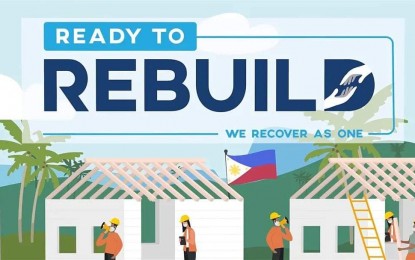
(Photo courtesy of NDRRMC)
MANILA – The National Disaster Risk Reduction and Management Council (NDRRMC), Office of Civil Defense, and the World Bank (WB) have expanded the council’s "Ready to Rebuild Program" through the conduct of four training runs from January to June this year.
The initiative supports ongoing rehabilitation efforts of communities severely hit by disasters, NDRRMC executive director Ricardo Jalad said in a statement Tuesday night.
"Rehabilitation and recovery do not begin only after calamities strike. We must start this process even before disasters hit,” Jalad said.
He noted that the four training runs are aside from the first four training batches held and completed last year.
"That’s the only way we can hasten our rebuilding after devastation, especially now that Typhoon Odette has reminded us once more how disasters ravage our communities and set back our development,” Jalad said.
"Odette", said to be one of the strongest typhoons to hit the country in recent years, made nine landfalls between December 16 and 17 in the provinces of Dinagat Islands, Surigao del Norte, Southern Leyte, Bohol, Cebu, Negros Oriental, and Palawan.
The fifth batch of the capacity building program, which ran from January 17 to February 2, prioritized the participation of 35 local government units (LGUs) from five "Odette"-affected regions to empower them in building back better, faster, and greener.
They are joined by 16 non-“Odette”-affected LGUs to round out the 51 participating local governments from 12 regions across the country.
To date, a total of 197 provinces, cities, and municipalities from all 17 regions are benefitting from the program.
A total of 287 trainees are currently learning from disaster risk reduction and management (DRRM) experts, as well as technical experts to build their capacity to deal with the aftermaths of disasters.
Local chief executives and technical staff – DRRM officers, planners, engineers, budget officers, and social workers – apply their learnings to complete and formulate their communities’ science-based pre-disaster baseline data, local disaster risk financing strategies, and local rehabilitation and recovery programs.
“Through the Ready to Rebuild Program, we are changing mindsets for pre-disaster rehabilitation and recovery. We are enabling local governments to put this at the forefront of DRRM planning and activities instead of as an afterthought,” WB senior disaster risk management specialist Lesley Jeanne Cordero said.
Cordero added that they are also ensuring that trainees would be equipped with the necessary knowledge, skills, and tools as they "make the shift from reactive to proactive policies."
"This way, communities can have a head start for an inclusive and resilient recovery when disasters come their way,” she added.
National government agencies, such as the Department of Human Settlements and Urban Development and regional offices of the National Economic and Development Authority and Department of Tourism, also participated in the fifth training run to focus on the recovery of key sectors, such as tourism and shelter.
Cordero said the "Ready to Rebuild Program" would complement the USD200 million dollars (PHP10 billion) withdrawn from the WB standby loan facility after the declaration of a state of calamity for Typhoon Odette response and recovery efforts.
Meanwhile, Jalad said the local recovery plans and outputs from the R2R Program could speed up access to the National DRRM Funds and other resources.
The sixth batch of the training program, scheduled from February 21 to March 11, is now open for registration with limited slots available.
LGUs that have not yet undergone the training are highly encouraged to contact the Ready to Rebuild Program Secretariat via [email protected] to secure their slots. (PNA)
